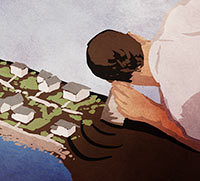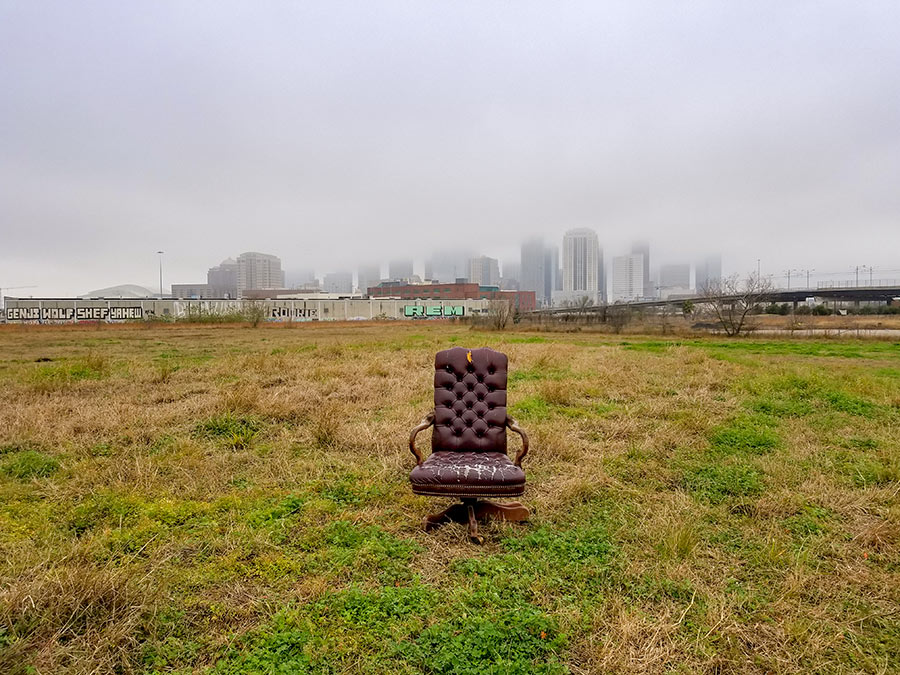Let’s kick off the nominating process for the 2011 Swamplot Awards for Houston Real Estate with this tried-and-true category: Favorite Houston Design Cliché. Past winners of this award include Lone Stars, “Lakes of” Subdivisions, and “Tuscanization.” What Houston building, shopping center, streetscape, home, interior, neighborhood, or yard cliché deserves recognition this year? Your suggestions for this award may be inspired from stories on Swamplot or from your own keen eye for overused detail.
 Nominations for this category are now open to your brilliant, clever, or possibly hackneyed suggestions! Enter your choice in a comment to this post only or — more privately — in an email the Swamplot tip line, with the subject line “Nomination: Favorite Houston Design Cliche.†Nominations will be accepted for one full week, after which the best-presented choices will be opened for voting.
Nominations for this category are now open to your brilliant, clever, or possibly hackneyed suggestions! Enter your choice in a comment to this post only or — more privately — in an email the Swamplot tip line, with the subject line “Nomination: Favorite Houston Design Cliche.†Nominations will be accepted for one full week, after which the best-presented choices will be opened for voting.
You can submit as many nominations as you like in this category, but your choices will have a better chance of succeeding if you use the opportunity to make your point in a clever and convincing way. When the actual awards are open for voting — next week! — each selected nomination will be introduced with some edited bastardization of the arguments made by the readers who submitted them. So be eloquent and persuasive! If you can send your own photos in support of a nomination, that will help a lot — and it’ll likely help you make your case to voters. Send images to the Swamplot tip line, but be sure to identify them and indicate what they’re for.
Comments to this post will be counted as nominations only. Nominations may be seconded, expanded, or improved. Even simple “me too†posts could help an entry find a place on the actual ballot, but they won’t be counted as votes for the winner. The actual voting in this category will begin next week. Are you ready? Send us your favorite clichés!
- Swamplot Award Nominations 2011 [Swamplot]





LEED-certified ‘green’ buildings! When the cost of proving one’s political correctness comprises up to half of the cost of actually being politically correct, that’s a design cliche in the making.
Its nothing against resource conservation or healthy work environments. Don’t get me wrong, that stuff is all fine and well. It’s just that a developer could’ve gone above and beyond with all the money they spend just to advertise that they’ve built something that is merely adequate.
LEED certification is to commercial real estate what Ed Hardy t-shirts are to douchebags. All flash, no substance.
I like the way so many swamplotters like to call anything that might “mimic” an older style…as FAUX_____. seems like Faux Stucco and Faux Tuscan have been thrown around alot…particularly regarding anything Weingarten has a mini thought about….faux faux faux! how dare they!
The New Charlestorleans style of the tone deaf builders who have been banished from stomping down bungalows in the Heights, but are in a building frenzy on the peripheries of the historic districts. A New Charlestorleans house is always two stories, porches on the first and second floors and an odd mashup of Gothic Revival, Federal, Greek, Italiante and the occasional touch of craftsman as a wink and middle finger to the poor slob across the street whose perfectly restored 1,100 sq ft 1920s bungalow now looks as out of place as UH on a BCS bracket. The New Charlestorleans style is basically the architectural version of Mr. Potatohead. Take a 2400-3200 sq ft box, stick on a Federal roof with some Italiante brackets on the cornice, Greek columns, a bit of the French Quarter wrought iron railing and whatever other odds and ends you dig up and you have a New Charlestorlean home ready to sell to the couple that loves the look of historic homes but doesn’t want the burden of keeping up repairs (and has no clue how shoddy new construction can be and how fast builders disappear into the wilderness once they have made their buck).
Creative use of columns on new houses. Nothing says classy and sophisticated taste like plastic columns stuck to your house (inside and out)
Giant metal chickens. They’re still only half as ubiquitous as metal stars, but thanks to the Bloggess they’re twice as hilarious. Knock knock, Houston.
How about the multi-material exterior apartment complexes? The Core on Washington was the first one I saw. Now there is 2525 Yale and others. Mixing brick with corrugated aluminum with hardi-plank definitely breaks up the monotony, but I wonder how well the aesthetics of the design will hold up 10 or 20 years from now.
How about Historic? You don’t even need to do any actual design…just pass an ordinance, mail a letter stamped COH – ensuring it gets tossed out with the junk mail – and BAM! With little to no effort OR design work you have a “historic” neighborhood. Just like I told the purchaser of my last house – that wood’s not rotting, it’s “historic!”
I’m with Zach and Old School. Houston’s Mish-Mash (miss-mash? miss-match?) of architectural styles is getting ridiculous. Pick a theme and stick with it and edit when necessary. More is not more people, seriously.
“Mixed used development”
I almost hate to propose these because they’re actually real modern design features, but I’m sure seeing a lot of monopitch roofs, butterfly roofs, and small, square clerestory windows on new construction. And aluminum-framed glass walls.
They built a McMansion across the street from me earlier this year (so much for the theory that McMansions were going extinct) and I was shocked to see all the “lick ‘n’ stick” fake rock on it. I always chuckled at the phrase “lick ‘n’ stick”, but having seen it put on a house, I can attest to its appropriateness. I don’t mind houses with non-functional decorative items–bring ’em on! But the utter fakeness and dishonesty of lick ‘n’ stick “rock” rubs me the wrong way, so that’s my vote.
How about a plenthora of art niches inside the cookie cutter, stone veneer & hardi rear, far-flung suburban tract homes. Yeah, a lot of avid art collectors live in those. Well, if you consider Thomas Kinkaid prints and “precious moments” figurines an art collection.
The guy above has a “perfectly restored 1,100 sq ft 1920s bungalow”. This is his way of crapping all over the people driving property values, as his 1100 square feet only allows 1 bathroom.
The “historic” part of the original neighborhood is that it was built during an awful time in America, when people were broke, and 2 bedroom, 1 bath houses were just cheaper — and often CARDBOARD CUTOUT homes literally ordered from a Sears Catalog.
Talk about design cliche. This means people wrap their historic thinking around pre-fabricated houses dumped on the masses to prey on their lack of spending power. I guaranty if the people forced to live like this were asked, they would have much preferred to build a 3 bedroom, 2.5 bath home like the original mansions of midtown/montrose, to at least have some connection to a coastal/low country culture.
Don’t be so smug. The true history of Houston is that many of the original people were largely relocations from the coastal regions of the southland. This includes Southern Louisiana, Mississippi, Alabama. The original houses and styles were indicative of their background, and so are the ones you poke fun at here.
“Designed” Grocery Stores. Seriously, I want to get my cart, get my food and drink, and get out of the building. I could care less who designed it and how nice it looks. If there’s no parking and the isles are convoluted cause some architect couldn’t design a rectangle, then I’ll just continue shopping at my undesigned store in a strip center.
As others have noted, my vote is for the “rock” that is applied over some exterior sheetrock. It started on small commercial structures several years ago ( see bank branches) and has now spread into the residential marketplace. In a city built atop clay and sand it always just seems a bit odd to me, like it’s trying to evoke “Denver on the Gulf” or something.
Old School is dead on with post #3. Dead. On.
How about stained wood exteriors that look like shit 6 months after completion?
LMAO @ the above comments.
@jg: The vast majority of the Heights bungalows were built in 1920. This was not an awful time in Houston, or the nation. Houston was in the middle of an oil boom. The bungalows provided newly emerging middle class families an opportunity to live in their own house instead of sharing a dingy tenenment with multiple families. 800-1000 sq ft bungalows were a big step up for many of the first residents. Many of the homes were ordered from catalogs and shipped to the home owner for assembly. But this did not mean that they were at all lacking in quality or design. In fact, the original bungalows were way over-engineered compared to today’s standards. Framing was old growth hardwood and siding was cypress, which holds up to the demands of termites and moisture. But, most importantly, the craftsman style was original and purely American. The Mr. Potatohead houses offer no originality and just hack up architectural styles to try to con people into believing that they are from another time. There are plenty of examples of new construction and rennovations in the Heights that are consistent with the period of the neighborhood’s craftsman architecture. It is not a difficult style to emulate. Thus, if you really want to see smug, take a look at the builders who ignore the history of the neighborhood in favor of their own hack imitation of southern architecture.
I would like to nominate the McCamelback.
I didn’t think I’d have one to add, but after reading the comments I’ll have to “me too!” the stupid looking fake rock siding. Can’t stand that look. Reminds me of cheesy Mexican restaurants that have fake stucco walls inside that look like they’re ‘broken’ only to expose some fake brick.
Plus one on LEED. Or the useless solar panels stuck on building roofs to make up like 1% of their energy usage until they fall apart through neglect.
By the by have the wind turbines been reinstalled on that downtown building?
In honor of the upcoming holiday season, can I nominate icicle Christmas lights?
In our climate, they just look silly.
@ Cranky: I recently was in a junk shop in Indiana listening to a pair dressed in Snuggie-wear carry on enthusiastically about a Thomas Kinkaide framed printed piece of paper they found in the bargain bin.
“It must be worth at least $500” said one of them.
One man’s mass-produced junk sold at Ross is another man’s treasure.
And yeah, when you’ve got an hour to kill in Indiana, a junk shop with Snuggies and Kinckaides is about as good as it gets.
I like lick and stick stone too, however it seems like we have had a version Of that for the last few years…. How about production builders use of the terms “custom” and “luxury”. Nothing says sophistication and taste like a cul-de-sac full of Trendmaker or Partners in Building houses.
There is some truth in about every post up here – including jg’s – but oh my God, you people are smug. Not everyone wants to live in a 900-sq.ft home with creaky floors, no central a/c and a bathroom that allows you to shit and shave at the same time. Get over yourselves.
alion, yeah but why do those people have to live in the heights. Blah blah property rights and all that but moving into a neighborhood and destroying it’s character with lot consuming houses isn’t exactly neighborly. Granted it’s the price you pay for living outside of deed restricted communities but that doesn’t mean their neighbors lose their rights to complain.
Following from 3, 4, 6, 8 and 19– Old School’s “Mr. Potato Head Construction” gets my nomination and vote!
Ladies and gentlemen, I present comment number 3. Read it. Over and over and over and over again.
Shopping centers with open metal canopies over the storefront windows. Even worse is when those canopies are stabilized by a turnbuckle system connecting the front of the canopy to the building. Even worse than that is when said turnbuckle’s point of attachment to the building is highlighted by a Texas star-shaped escutcheon plate.